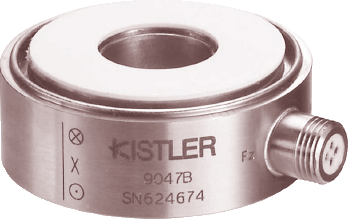Store
Kistler Force Series
Force, like any other physical phenomena, cannot be measured without disturbing the phenomenon being measured. Most force sensors have an elastic sensing element, whose deformation is a measure of the acting force.
In many force measurement systems (i.e. strain gauges, inductive and capacitive systems), this deformation itself must be measured. The sensing element must have enough compliance to provide sufficiently large deformation and hence useful sensitivity. These large deformations are undesirable because they limit the frequency response of the measuring system and also introduce geometric changes into the force measuring path which inevitably leads to measurement errors (i.e. linearity and hysteresis).
In piezoelectric force sensors the sensing element is the same as the transaction element which produces the electrical output signal from an acting force. Therefore, it is not necessary to measure the deformation (which will be much smaller than with other measuring systems). The resultant high rigidity of piezoelectric force sensors greatly reduces the disturbance (or geometric changes) caused by the measurement and provides an inherently high natural frequency and associated rise time. This permits the measurement of extremely fast events (such as shock waves in solids, impact printer and punch press forces) that otherwise might not be possible.
While piezoelectric force sensors are ideally suited for measuring dynamic events, they cannot perform truly static measurements. Although the electrical charge delivered under a static load can be registered, it cannot be stored for an indefinite period of time. For static measurements, highly insulated materials must be used for the sensor cables and connectors to insure a maximum discharge time constant and optimal operation of the charge amplifier (i.e. minimal draft). Quartz is used in all Kistler force sensor designs. Since it has an ultra high insulation resistance, static measurements are more feasible with quartz than with any other piezoelectric material. In fact, quartz -based piezoelectric systems can routinely measure large forces for minutes and perhaps even hours. Low level forces can be measured "statically" for much shorter intervals. This is why Kistler piezoelectric force sensors are often described as being "quasistatic."
PIEZOTRON® force sensors use the same quartz sensing element as standard (charge output) piezoelectric units and also have a miniature, built-in charge-to-voltage converter for low impedance voltage output. This allows the usage of general purpose cable in environments where moisture or contamination would be detrimental to the high insulation resistance required with high impedance sensors. PIEZOTRON force sensors have time constants long enough for calibration, but usually not long enough for static measurements. For this reason they are usually restricted to dynamic applications.
Applications:
Material testing, impact forces
Machinery and assembly tests
Insertion, extraction monitoring
Component insertion
Bearing reaction, machinery testing
Bolt, clamping and punch press forces
Features:
Compression and tension
Preloaded assembly
High rigidity, easy installation
Force ranges to 270,000 lb.
Wide measuring range (1 to 1,000,000)

